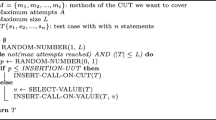Abstract
In Extreme programming unit testing is organized so that the unit tests are written before coding commences. For many programmers the selection of the test cases is something of an “ad hoc” process. Where programmers are experienced in writing test sets it is common for them to use white box or structural test techniques. However, these rely on the structure of the code being available which is not the case with XP. This article describes a principled way of creating powerful, functional unit tests from informal descriptions of the units.
Visiting Researcher from China Xi’an Satellite Control Centre.
Access this chapter
Tax calculation will be finalised at checkout
Purchases are for personal use only
Preview
Unable to display preview. Download preview PDF.
Similar content being viewed by others
References
M. Holcombe: X-Machines as a Basis for Dynamic System Specification. Software Engineering Journal, 1988, Vol3, 69–76.
M. Holcombe and F. Ipate: Correct Systems: Building a Business Process Solution, Springer Verlag, Berlin, 1988.
T. Balanescu, T. Cowling, H. Georgescu, M. Gheorghe, M. Holcombe and C. Vertan: Communicating Stream X-Machines Systems are no more than X-Machines, J.UCS, 1999, Vol. 9, 494–507.
M. Holcombe, K. Bogdanov and M. Gheorghe: Functional Test generation for Extreme Programming, Second International Conference on extreme Programming and Flexible Processes in Software Engineering XP2001, Sardinia, Italy, 2001, 109–113.
M. Muller and W. Tichy: Case study: Extreme programming in a university environment. 23rd International Conference on Software engineering, Toronto, Canada, 2001, 537–544.
D. Stotts, M. Lindsey and A. Antley: An informal formal method for systematic Junit test case generation, in D. Wells and L. Williams (Eds), XP/Agile Universe 2002, LNCS 2418, 2002, 131–143.
T. Sun Chow: Testing Software Design Modeled by Finite State Machines. IEEE Transactions on Software Engineering, May 1978, Vol.SE-4(3), 178–187.
S. Fujiwara, G. von Bochmann, F. Khendek, M. Amalou and A. Ghedamsi: Test Selection Based on Finite State Models. IEEE Transactions on Software Engineering, 1991, Vol.17 591–603
T. Ramalingam, A. Das and K. Thulasiraman: Fault Detection and Diagnosis Capabilities of Test Sequence Selection Methods Based on the FSM Model. Computer Communications, 1995, Vol.18, 113–122.
S. Eilenberg: Automata, Languages and Machines.1998, VolA, Academic Press, New York.
F. Ipate: Theory of X-Machines and Applications in Specification and Testing. PhD thesis, Department of Computer Science, University of Sheffield, July 1995.
A. Cowling, H. Georgescu, C. Vertan: A Structured Way to Use Channels for Communication in X-machine System. Formal Aspects of Computing, 2000, Vol. 12,458–500
S. Vanak: Complete Function Testing of Hardware Description. PhD thesis, Department of Computer Science, University of Sheffield, 2002
Author information
Authors and Affiliations
Editor information
Editors and Affiliations
Rights and permissions
Copyright information
© 2003 Springer-Verlag Berlin Heidelberg
About this paper
Cite this paper
Yuan, J., Holcombe, M., Gheorghe, M. (2003). Where Do Unit Tests Come from?. In: Marchesi, M., Succi, G. (eds) Extreme Programming and Agile Processes in Software Engineering. XP 2003. Lecture Notes in Computer Science, vol 2675. Springer, Berlin, Heidelberg. https://doi.org/10.1007/3-540-44870-5_21
Download citation
DOI: https://doi.org/10.1007/3-540-44870-5_21
Published:
Publisher Name: Springer, Berlin, Heidelberg
Print ISBN: 978-3-540-40215-2
Online ISBN: 978-3-540-44870-9
eBook Packages: Springer Book Archive




